At Dengie we use a range of ingredients to supply fibre for horses. The latest ingredient to be introduced to our portfolio of ingredients is pea hull fibre. As the name suggests, the fibre comes from peas and is the hull from the pea itself rather than the pod.
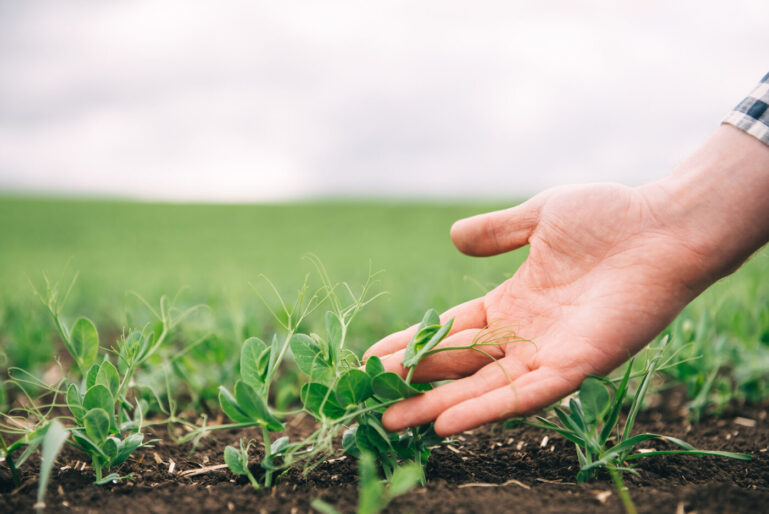
Farmer is studying the development of vegetable peas. Farmer is caring for green peas in field. The concept of agriculture. Farmer examines young pea shoots in a cultivated agricultural area.
Benefits of pea hull fibre for horses
Pea hull fibre provides a mix of different fibre types whilst being very low in sugar and starch. Of the fibre content, around 20% is pectin which is a highly digestible form of fibre for the horse. There is also a very low level of lignin which means the fibre that is present is very easy for the horse to access and utilise – in contrast to more lignified forages like straw and late cut hay.

Wooden spoon of dried green pea flour on top of dried green split peas. Top view.
The hulls of legume seeds such as peas are a good source of natural anti-oxidants too in the form of poly-phenols such as flavonoids. These are one of the reasons humans should eat at least 5 portions of fruit and veg a day as it means we consume these natural nutrients that are beneficial for health. As good doers are typically on limited pasture, they miss out on many natural nutrients and so using a wide range of ingredients in the bucket helps to counteract the lack of pasture.
Why have we included pea hull fibre?
 Pea hull fibre is featuring in Meadow Lite with Herbs which is based on straw with a very small proportion of grass to try and keep the sugar and energy values low. Straw is a great source of fibre but it doesn’t contribute many other nutrients and so pea hull fibre has been included to supply some minerals such as calcium and potassium. Meadow Lite with Herbs is still a straight feed but supplements and balancers are designed to be fed alongside ‘average’ forages and rations. Good doers are often fed restricted amounts and when straw makes up a significant proportion of the ration, levels supplied by the forage are lower than average. The addition of pea hull fibre helps to counteract that.
Pea hull fibre is featuring in Meadow Lite with Herbs which is based on straw with a very small proportion of grass to try and keep the sugar and energy values low. Straw is a great source of fibre but it doesn’t contribute many other nutrients and so pea hull fibre has been included to supply some minerals such as calcium and potassium. Meadow Lite with Herbs is still a straight feed but supplements and balancers are designed to be fed alongside ‘average’ forages and rations. Good doers are often fed restricted amounts and when straw makes up a significant proportion of the ration, levels supplied by the forage are lower than average. The addition of pea hull fibre helps to counteract that.
FAQs about pea hull fibre
Do horses like pea hull fibre?
The pea hull fibre has been tested with a wide range of horses and ponies during the development trials of Meadow Lite with Herbs. The feed has been eaten up well and so we can conclude that pea hull fibre is palatable when included as part of the ration.
Is pea hull fibre high in protein?
No, in fact it is very low in protein as it is just the fibrous hull from around the pea. Pea protein has become a popular source of plant protein in recent times but that comes from the pea itself. The demand for the protein has made the pea hull fibre a more abundant ingredient available for use in animal feed.
Is the pea hull extracted using chemicals?
No, the hull is removed mechanically using a gentle brushing and rubbing technique. Air is then used to move the fibre through a grinding process to create a flour-like texture. Heat is applied to ensure it is free from any microbes and therefore safe to use as a feed ingredient.
For further advice on pea hull fibre for horses or to receive a personalised ration plan for your horse call the Dengie Feedline on 01621 841188 or complete our Feed Advice Form.
A common question we see being asked on social media is ‘Can I feed chopped alfalfa to horses with ulcers?’ Unfortunately, a lot of confusion surrounds the relationship between alfalfa and gastric ulcers. This is often because key details from research papers are missed or omitted to such an extent that the original findings are completely lost in the inevitable soundbites that perpetuate, particularly on social media.

It is very important to start by noting that no studies have been published that have found a negative effect from feeding alfalfa to adult horses for any kind of ulcers or for any age of horse in relation to squamous ulcers.
Papers found positive effects from feeding alfalfa to horses
In fact, many papers have been published that found positive effects from feeding alfalfa to horses at levels that reflect typical practices such as Lybbert et al. (1997), Nadeau et al. (2003), Bäuerlein et al., (2020). Anecdotally, many vets and researchers exploring treatment options for ulcers, recommend alfalfa as part of the ration for both horses with Equine Squamous Gastric Disease (ESGD) and Equine Glandular Gastric Disease (EGGD). In the EGGD consensus statement from leading veterinary researchers, chaff or other forage is recommended to be fed before exercise. Whilst the authors don’t state alfalfa specifically, they equally do not recommend to avoid feeding chopped alfalfa to horses, which they would clearly do if there was any evidence of it being a risk factor or issue for horses diagnosed with EGGD.
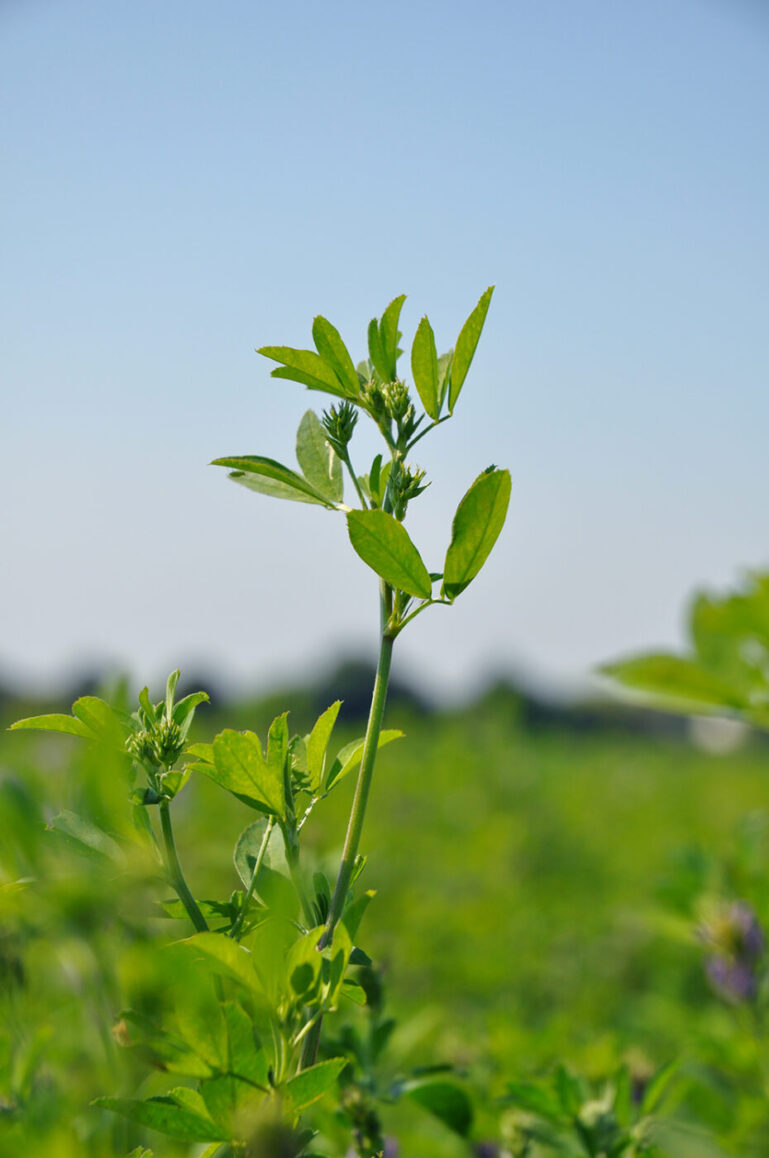
Why are some people concerned about feeding chopped alfalfa to horses?
To date, the papers cited by those suggesting chopped alfalfa isn’t suitable for horses emanate from one research group based in Germany and relate to some studies conducted in weanling foals.
So let’s take a closer look at this work by Fetke et al. (2015) and Vondran et al. (2016). This was first presented at the EWEN conference in 2014 by the research group leader Professor Ingrid Vervuert. There are a few important points to consider in relation to these papers:
- Both come from the same research group based in Germany.
- They are both in weanling foals – EGGD is recognised as being correlated with stress, as well as other factors such as pain
- The incidence of ulcers was high at the start of the study even before any of the trial diets were introduced
It is also very important to consider how much alfalfa chaff was fed to foals in these trials. In Fedtke et al. (2015) the weight of alfalfa was 5.5kgs of alfalfa chaff (between 11 and 15 Stubbs scoops) along with corn silage, grass silage and 2kgs oats. In Vondran et al. (2016) the level of alfalfa fed was 3kgs (6 Stubbs scoops) which was again alongside oats.
Nowhere near this level of alfalfa chaff is fed to weanlings in the UK and so this study is not reflective of a real-world scenario. Does this mean it should be disregarded? No, but equally it doesn’t mean we should conclude with any certainty that more typical levels of alfalfa chaff, i.e. 1 to 2 Stubbs scoops or 1kg per day, present a risk even to weanling foals. In fact, the authors themselves state that “from our study it is still not clear whether the fine or the harsh structure may have an impact on mucosa health”.
Research found that alfalfa hay positively affects the squamous mucosa
A subsequent paper from the same research group (Bäuerlein et al., 2020) compared alfalfa hay to grass hay. They found that alfalfa hay positively affects the squamous mucosa. Professor Vervuert who co-authored the Fedetke and Vondran papers, presented a paper in March 2023 where she referred to alfalfa as the “Queen of forage plants” and made no reference to needing to use it with caution for any horse with ulcers. She also advocates the use of straw in the same paper. Proceedings are available from: 11th EEHNC | Equine Health and Nutrition Congress (equine-congress.com)
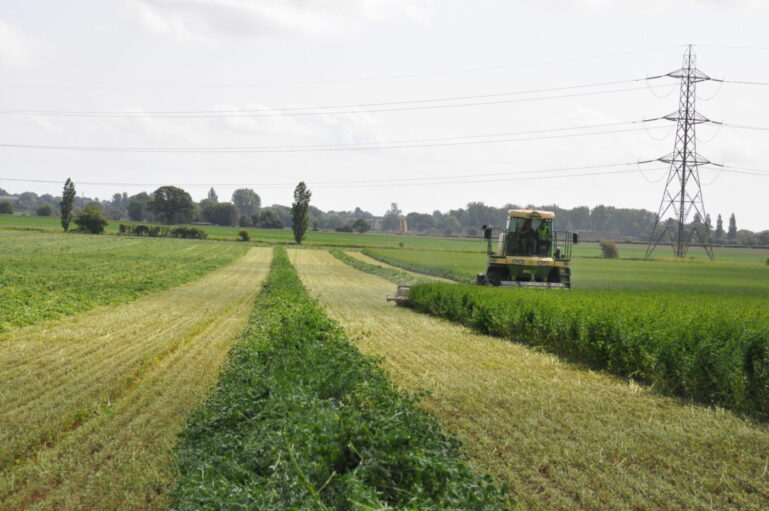
Another paper that is often cited inaccurately is le Jeune at al. (2009). This paper explored brood mares kept at grass fed either alfalfa hay or a mix of alfalfa and grass hay with all mares receiving a relatively small amount of grain (0.9kgs). The mares were kept in groups so there was no way of knowing how much each of the mares consumed, which is a limitation of a study conducted in a commercial stud. The authors also note that the limitation of this study was that it was on one stud farm, in one location. Despite being at pasture, mares in both groups had ulcers. The authors do not attribute this to the presence of alfalfa in the ration. In fact they highlight the exact opposite position in their discussion:
“A direct link between diet and gastric ulceration in our population of mares could therefore not be made. It is possible, however, that the mares in our study are prioritizing the highly palatable grain for alfalfa hay and grass from the pasture and are therefore minimizing the buffering effects of alfalfa and pasture grazing, potentially contributing to the higher than expected prevalence of gastric ulceration in this population”
The authors are suggesting that it is the lack of the mares consuming the alfalfa that means the beneficial buffering conferred from consuming alfalfa is not achieved.
What can we conclude about feeding chopped alfalfa to horses?
The aim of sharing this information is to try and present the results from studies in a balanced way, exploring the details from the studies that matter: how much chopped alfalfa is fed to horses, to what age of horses and in what circumstances. With this detail we can make an informed decision as to the relevance of these findings to our own horses when they do not reflect the findings of any other study and when vets, researchers and experienced nutritionists from around the world advocate the use of alfalfa.
If you have any further questions about feeding chopped alfalfa to horses with ulcers or would like our nutrition team to review your horse’s ration please call our Feedline on 01621 841188 or fill in our Feed Advice form.
When the price of things we purchase goes up significantly, it is inevitable that we review whether or not we really need or want them. Horse feed is no exception and, at first glance, adding chopped fibre to your horse’s bucket feed may seem a bit superfluous. To some it may even feel like the garnish to the main meal; for others it’s something they do because they’ve been told it’s important but without really understanding why. Below our nutrition team explain the important role of chopped fibre and why horses and ponies with Equine Metabolic Syndrome (EMS) and PPID may particularly benefit from chopped fibre as part of their bucket feed.
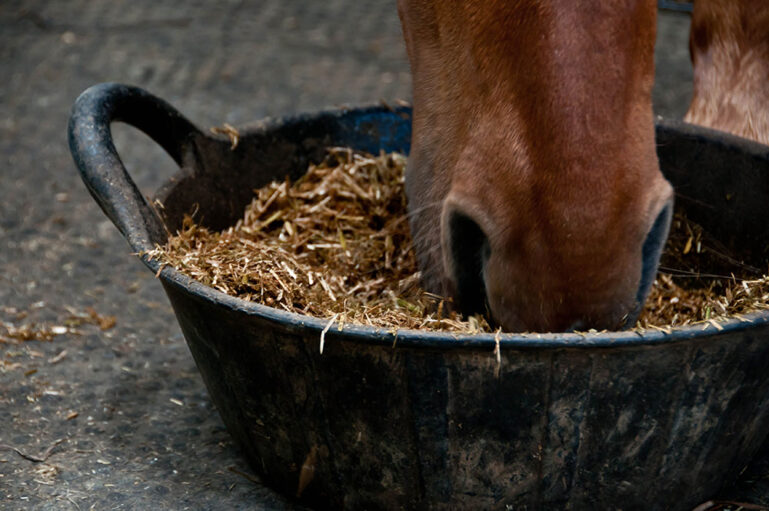
What does adding chopped fibre to your horse’s feed do?
The addition of chopped fibre slows the rate at which your horse consumes their feed, also referred to as rate of intake. Studies show it takes horses significantly longer to consume pelleted feeds if chopped fibre is added (Ellis et al., 2005). In this study the addition of chopped straw, at an inclusion rate of 20%, to a ration containing pellets and other chopped fibres resulted in significantly longer eating periods and increased the number of chews.
More chews results in more saliva which is a natural buffer to acidity in the digestive system. The more we can do to increase the number of chews the horse makes, the more we’re helping to maintain a healthy gut.
Does the fibre type matter?
Studies have shown that straw is consumed significantly more slowly than hay (7.9 g compared to 14g of dry matter per minute) (Dulphy et al., 1997) and a more recent study by Jansson et al. (2021) found that 50% wheat straw fed with haylage was consumed more slowly than haylage alone.

Are there benefits to slowing your horse’s intake as much as possible?
The slower rate of consumption of straw mixed with haylage resulted in a lower insulinaemic response – the level of insulin the horse produces to manage the rise in blood glucose levels after eating feed. In fact, in the evening when the rate of intake was slowest, there was no significant increase in insulin levels at all. This study was carried out in horses considered to have relatively normal insulin sensitivities but this effect could be even more beneficial to horses and ponies with insulin dysregulation (ID). ID is associated with diseases like PPID and EMS.
A recently published study (Macon et al., 2022) showed that horses with ID had a greater insulinaemic response to as little as 0.1g/kg bodyweight of non-structural carbohydrate (NSC) compared to horses without ID. NSC is the combined values of sugar and starch and a level of 0.1g/kg is very low. A key point from this study is that all horses consumed the feeds being tested in around 10 minutes which is relatively typical for a bucket feed. This finding, combined with the findings from Jansson et al. (2021) highlight the importance of not only using low NSC feeds but also slowing the rate of intake as much as possible when managing horses with ID.
Key Concepts to Take Away
- The use of feeds with higher levels of NSC can reduce insulin sensitivity in any horse – even youngstock have been shown to have reduced insulin sensitivity when fed higher levels of starch based feeds
- Horses and ponies with ID are more likely to have exaggerated insulinaemic responses to even very low levels of NSC intake
- A slower rate of intake can help to modulate the insulinaemic response
- Consider using straw both in the bucket feed and mixed with other forage to slow the rate of intake and therefore reduce the insulinaemic response
- Whilst these studies use small numbers of horses and ponies, they are published in peer-reviewed journals and so provide us with valuable insights to how we can best manage our horses and ponies.
For more information on what to feed your horse or advice on all aspects of feeding call the Dengie Feedline: 01621 841188 or complete our Feed Advice Form.
References:
- Ellis et al (2005) Adding Chopped Straw to Concentrate Feed
- Dulphy et al (1997) Compared feeding patterns in ad libitum intake of dry forages by horses and sheep
- Jansson et al (2021) Straw as an Alternative to Grass Forage in Horses—Effects on Post-Prandial Metabolic Profile, Energy Intake, Behaviour and Gastric Ulceration
- Macon et al (2022) Seasonal Insulin Responses to the Oral Sugar Test
Simply read through the article and answer the following questions to be in with a chance of winning £30 of Dengie Feed Vouchers*
Zoos play a key role in conservation and education. Animal welfare is of the utmost importance and providing the right diet for the wide range of different species they care for is key to the success of breeding programmes as well as the health and wellbeing of the animals. Just as horses are herbivores and so require a high fibre diet, so are many zoo animals and finding the right sources of fibre is vital. Understanding zoo animal diets depends on a number of things which we cover in the article below.
Animals in their natural habitat
In their natural environment, browsers such as antelopes and giraffes generally wouldn’t have a problem finding suitable high fibre materials. In Africa, they would usually feed on acacia and other browse material which are very nutritious with appropriate fibre levels. Acacia has spines which animals have to use their long tongues to negate; this is believed to be so they can’t strip leaves, preventing complete defoliation of the plant. Browsers such as Okapi are able to select desirable items of browse material by reaching up into the canopy with their tongue which can extend to around 18 inches!
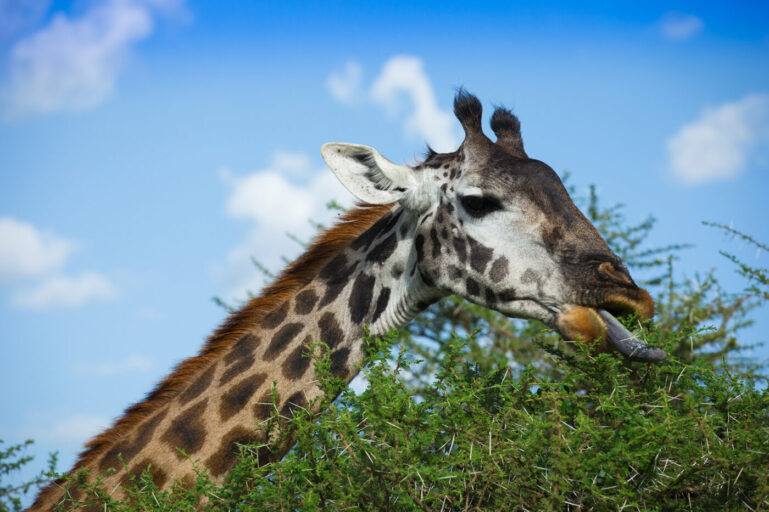
History of feeding zoo animals
Historically, most zoo animal nutrition for browsers was based on what suited giraffes as they have been relatively common in zoos. This led to many other species being fed inappropriately, often being given too much grass-based forage as this was most readily available, but even holly was picked and conserved for zoo animals in the 17th and 18th centuries. Inevitably, like horses and other farm animals, zoo animals have also been fed cereal based feeds designed for intensive livestock production. Just as with horses and other livestock, high cereal diets can cause significant issues in the digestive system, such as acidosis due to rapid rumen fermentation in zoo animals too. Inappropriate nutrition also resulted in poor dentition and acute mortality syndrome in some zoo animals as well.
Over the last decade in particular, there has been a concerted effort to grow sources of browse material for zoo animals. It can be difficult to source browse material in larger quantities, so some zoos now have their own plantations using plants such as willow which is quick growing, to provide sufficient material for the animals. Alongside this, alfalfa has made a significant improvement to zoo animal diets and is easy and efficient for zoo keepers to use.
Feeding alfalfa to zoo animals
Alfalfa has a very different botanical classification and cell structure to grass, but has a protein and nutrient content similar to acacia which makes it very suitable for feeding to a wide range of zoo animals. As ever, the closer to the natural diet the better for the animal and the lower risk of problems.
Alfalfa provides more quality protein compared to grass as well as being a more digestible fibre source. Grass hay has a high silica content which is an abrasive material that wears down teeth. Feeding too much grass hay to browsers such as giraffes, whose teeth have a low crown and thin layer of enamel, can result in excessive dental wear due to the silica content. Alfalfa has a naturally low silica content so is much less abrasive to teeth compared to grass.
Andy Beer is a nutritionist specialising in zoo animals and is a strong believer in feeding alfalfa. Andy previously ran training schemes both in the UK and internationally for zoo keepers. Having taught nutrition at University level for more than 20 years, he became a zoo nutritionist for 11 years at the Royal Zoological Society of Scotland with their two animal collections at Edinburgh Zoo and the Highland Wildlife Park. Andy now works freelance giving nutritional training and advice to a number of different zoos in the UK, Europe and the Middle East.
“Alfalfa is the best alternative to natural browse” says Andy. “It is highly beneficial to a number of different species due to its structure, composition, fermentation characteristics and low silica content. I also value its high calcium and magnesium content compared to grass. Adequate and appropriate nutrition is not something that should happen by coincidence but should be properly planned for zoo animals and using high quality feeds is vital for their welfare”.
Andy uses a variety of formats of alfalfa including hay or haylage, as well as chopped and pelleted alfalfa such as Dengie Alfalfa Pellets or feeds in the Dengie Alfa-A range. Andy has also been training our team of nutritionists and feed advisers to ensure we are best placed to provide support and advice for zoos too. “Although there are some key principles that apply to horses and zoo animals, the scales of what these animals can consume is amazing” commented Tracey Hammond a senior nutritionist at Dengie. “An elephant may consume over 100kgs a day which is about 50 times more than a very large horse should be eating!”
Feeding at Paradise Wildlife Park
Paradise Wildlife Park in Hertfordshire have been feeding Dengie Alfa-A Original to their various zoo animals for over 15 years. The animals fed on Dengie Alfa-A Original include Lowland Tapir, Plain Zebra, Bactrian Camels and Red Deer.
“At Paradise Wildlife Park we have used Dengie’s Alfa-A Original for many years now across various species” explains James Cork, Head Keeper. “We mix the Alfa-A Original alongside their concentrate feeds and have found this to be a great product for increasing the animals’ roughage. It’s clear to see that all the animals enjoy their Alfa-A, particularly our Bactrian Camels who love grabbing mouthfuls out of their feed buckets before we have even placed the food in their troughs!”
The animals at Paradise Wildlife Park are fed hay and straw alongside their Alfa-A Original as well as a specialist browser pellet to provide them with the vitamins and minerals they need. They also eat a variety of different fruits and vegetables such as peppers, pumpkin and carrot. They have various forms of enrichment including treat balls, branches and forage at varying levels including hay racks and feed troughs.
If you have any questions or would like more information on zoo animal nutrition, don’t hesitate to get in touch with our team today via the Dengie Feedline: 01621 841188.
Dengie also recently organised a webinar on Saving and Caring for Exotic Species with guest speakers Tullis Matson, founder of Nature’s Safe and Andy Beer, zoo animal nutritionist of Zoocraft Limited. The recording of the webinar can be found on our YouTube Channel.
*Terms & Conditions: This competition will close at 11.59pm on 31st December 2022. One entry per person. One lucky winner will be selected from the correct entries and be notified via email within 7 days of the competition closing. No cash alternative available. Entrants must be aged 18 or over. Open to UK mainland residents only. Click here for full terms & conditions
A lot of myths and misinformation circulate about sugar which leads to confusion about what sugar is, where it comes from and which feeds are suitable for different types of horse and pony. Common questions include “can horses eat sugar?” through to “is sugar bad for horses?” The first key fact to be aware of is that grass and grass-based forages are the greatest source of sugar in most horse’s rations. The table below highlights the levels of water soluble carbohydrate (WSC) provided in a ration that is typical for a good doer. WSC includes simple and storage forms of sugar. It is important to note this is not a balanced diet as too little of the Pony Cubes is being fed to supply the correct levels of vitamins and minerals but it is, nonetheless, a common approach. By far the biggest source of WSC is the hay. Even if a lower WSC hay is used it is still going to be the greatest source of sugar in the ration.

Sugar Levels in Forage
The level of sugar in grass will vary according to a number of variables such as time of day, season, climate and the variety of grasses present in the sward. The level of sugar is usually highest in the afternoon of bright sunny days when the plants have been photosynthesising for longest. This is why it is recommended to turn those at risk of laminitis out overnight and bring in by mid-morning at the latest.
How much sugar is safe for your horse depends on your horse’s condition and physiological status. It is recommended that horses that are overweight, suffering with insulin dysregulation, prone to laminitis or with PPID should be fed less than 12% non-structural carbohydrate (NSC) in the total diet. NSC is the total amount of simple sugar, storage sugar and starch. This would effectively mean very little, if any, pasture can be consumed and a mature, highly fibrous forage should be used. Finding a low sugar hay for horses can be very difficult and although some types of grass such as Timothy, tend to be lower in sugar, it isn’t always the case. Click here for more information on choosing the right forage for horses prone to laminitis.
Sugar free horse feeds – do they exist?
Most fibrous materials, including straw, contain some sugar and so sugar free feeds don’t exist. No added sugar is a more accurate term and in the context of chopped fibre feeds it means the fibre either has no coating added at all or an oil coating has been used which doesn’t contribute any sugar. The base ingredients will naturally contain some sugar. Some supplements may be sugar free if they don’t contain any plant material but these are very much supplements and not feeds.
Sugar analysis and declarations
Analysing forage is recommended when seeking low sugar feeds for horses, but the results are only as good as the sampling methods used. Taking samples from a selection of bales is the best way to get a better impression of the sugar levels in a forage, but it isn’t always possible to do so. In these situations the analysis is giving an indication or a guide and it is worth taking samples on a number of occasions if it is only possible to sample one bale at a time.
Horse feeds that are based on cereals are most likely to declare a simple sugar level as they don’t typically contain a high proportion of grass and so analysing for WSC is less relevant. The sugar analysis will pick up simple sugars from ingredients like molasses. When it comes to chopped fibres and other high fibre feeds then WSC is a useful value to have especially if the feed contains dried grass. If a company gives a sugar value on a grass based fibre feed it is worth contacting them to be sure if they have also analysed WSC as this will present a very different picture to a simple sugar value.
Inevitably there will be some variation in levels for every product no matter who produces it. A difference of 1 or 2% in declared levels between products makes very little difference as the actual level in the bag could easily vary that much between batches. Seeking feeds that are well below the 10-12% NSC recommended for horses and ponies prone to laminitis is therefore key. For more information please visit our detailed laminitis page.
What about molasses – is it safe for horses?
Molasses is a dark brown syrup produced as a by-product from the sugar industry and can come from either sugar cane or sugar beet. The first point to note is that molasses is from plant origin and so is a natural feed ingredient. It is also worth noting that it is a co-product from another industry which means a valuable resource is being fully utilised rather than going to waste. With sustainability of food and fuel production of ever-increasing importance, this is an important factor to consider.
What is molasses used for?
Molasses is primarily used to naturally sweeten feeds to enhance their palatability; the sweetness comes from its sugar content. A recent study analysed 32 samples of molasses from around the world and found that sucrose was the greatest form of sugar in both cane and beet molasses. Sucrose is a disaccharide (2 sugar) made up of glucose and fructose. The table below shows the range of sugar levels from the different molasses analysed in the study. Although the sucrose level in beet molasses is higher, it contains very little of the glucose and fructose in their single sugar form (monosaccharides) whereas cane molasses contains less sucrose than beet molasses but more of the sugars in their single form. When all the sugar levels are added together, the totals are very similar between the two types of molasses.
| Source of Molasses | Average Sucrose % | Average Glucose % | Average Fructose % |
|---|---|---|---|
| Cane | 48.8 | 8.1 | 5.3 |
| Beet | 60.9 | 0.3 | 0.3 |
How does sugar in molasses compare to sugar in grass forages?
Data from a study in Sweden showed that in grass pasture allowed to mature to make hay, the sucrose content was 3.3% of dry matter (DM), glucose was 3.6% DM and fructose 2.6% DM. The total water soluble carbohydrate (WSC) content was 10% which is relatively low compared to many grass based forages produced in the UK. So, what we should take from this information is that the same forms of sugar are found in molasses and grass so we shouldn’t view the sugar in molasses as unnatural.
What matters about sugar in molasses?
What matters is how much is fed in total and how much is consumed at one time which can also be viewed as the rate of intake. The levels of sugar provided by the hay made from the grass in the study in Sweden are shown in the table below. The total intake from 7.5kgs dry matter, the minimum amount recommended for a 500kgs horse, would supply around 650grams of sugar.
| Sugar | Level in Hay % | Grams provided if feeding 7.5kgs Dry Matter |
|---|---|---|
| Glucose | 4 | 300 |
| Sucrose | 1.4 | 105 |
| Fructose | 3.2 | 240 |
To put this into context, to supply the same total amount of sugar from molasses it would be necessary to feed just over 1kg of pure molasses. Clearly this is never likely to be done intentionally! In reality, molasses is added at very low levels to feeds which are then fed in much smaller quantities than grass-based forages and so the actual amount of sugar supplied from molasses is very low. A scoop of Alfa-A Original which weighs about 400grams would provide about 40grams of sugar.
Of course, for horses and ponies that require as low levels of sugar as possible in their diet, then our range of molasses free feeds are the low sugar, high fibre horse feed that these horses need but a reduction in grass based forage intake is often also required. For horses and ponies that are in work and of a healthy weight with no underlying health issues, molasses is an acceptable ingredient when included in moderation.
For more information on what to feed your horse or pony or for help and advice on all aspects of feeding call the Dengie Feedline: 01621 841188 or complete our Feed Advice Form.
Shetland ponies are popular as companions, children’s ponies, or pets due to their lovable nature, cute appearance, and cheeky characters. They originate from the Shetland Isles in the North of Scotland which is a harsh environment relative to most of the UK. This means the grazing is sparse so it’s no surprise that when they are given access to lush pasture, they can easily become overweight and are prone to issues such as laminitis.

What to Feed a Shetland Pony
What to feed Shetland ponies will depend on the individual but, in general, forage and some access to grass will be the majority of most Shetland pony’s diets. In most cases, access to grass will need to be limited – the challenge with Shetlands is usually keeping them on a calorie controlled diet!
However, like any horse or pony it is important to provide them with all the vitamins and minerals they need for a balanced diet. UK pastures lack a number of trace minerals including zinc, copper and selenium as well as vitamin E in conserved forages. Vitamins and minerals are important for many different functions such as energy breakdown and utilisation and as part of the body’s antioxidant defence system. This means we need to supplement the vitamins and minerals in their ration to provide them with a balanced diet.
Shetland Pony Feed from the Dengie Range
Dengie Healthy Hooves Molasses Free is a complete feed so when fed at the recommended quantity of 500g per 100kg bodyweight per day, will provide all the vitamins and minerals needed for a balanced diet as well as biotin for hoof health and MSM for joint support. It is low in calories, sugar and starch making it ideal for feeding Shetland ponies who maintain their weight easily.
“Dengie Healthy Hooves Molasses Free is perfect for Little Alf” explains Hannah Russell. “It helps me keep a watch on his waistline, whilst the vitamins and minerals keep his hooves and joints in perfect condition which is very important when he has to look good for his adoring public!”
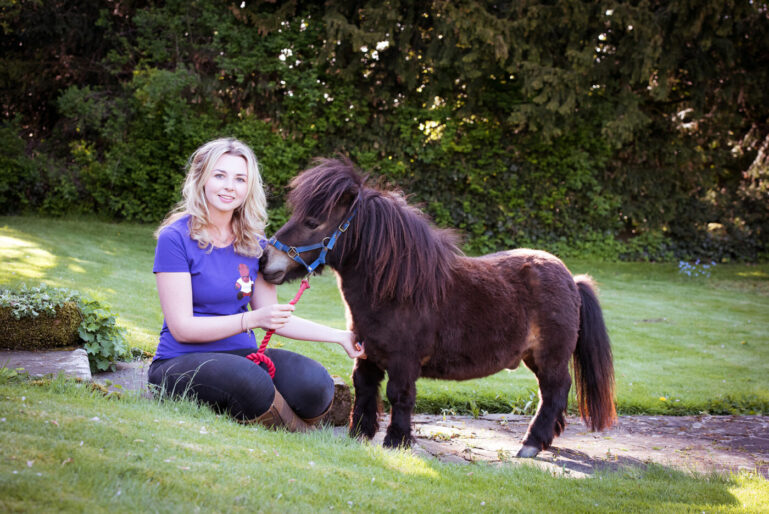
Dengie Hi-Fi Lite or Hi-Fi Molasses Free are two other great options for feeding Shetland Ponies that are good doers. Both the Hi-Fi Lite and Hi-Fi Molasses Free are low in calories, sugar and starch. They don’t have added vitamins and minerals so we would suggest feeding a feed balancer or powdered vitamin and mineral supplement alongside.
Shetland Pony Feeding Guide
| Bucket Feed | Miniature Shetland (Approximate weight 100kg) | Standard Shetland (Approximate weight 200kg) |
|---|---|---|
| Healthy Hooves Molasses Free | 500g or 1 Stubbs scoop per day | 1kg or 2 Stubbs scoops per day |
| Hi-Fi Molasses Free & Basic Spec Vits & Mins | Up to 500g per day & Manufacturers Feeding Rate | Up to 1kg per day & Manufacturers Feeding Rate |
| Hi-Fi Lite & Basic Spec Vits & Mins | Up to 500g per day & Manufacturers Feeding Rate | Up to 1kg per day & Manufacturers Feeding Rate |
Forage and Grazing
How much hay to feed a Shetland pony would depend on the individual. For good doers and overweight ponies, we would suggest feeding 1.5% of their bodyweight dry matter in fibre per day. This can be reduced if they are out at grass. For example, a Shetland out at grazing 24/7 may not need any additional hay if there is enough grass available.
It can also be a good idea to soak your Shetland’s hay if they are a good doer to help reduce the sugar content. Using small holed haynets and double netting will also help their hay allowance last them longer.
You may also want to restrict your Shetland’s grazing where possible to help reduce the amount of grass they are able to eat, particularly if they are overweight or prone to laminitis. Grazing can be restricted by methods such as strip grazing, wearing a grazing muzzle, creating a track system, moving them to a barer patch, or reducing the time they are out at grass for.
Feeding Shetland Ponies Treats
We often get asked about feeding treats, for example, can you feed a Shetland Pony Carrots? Shetlands and other breeds of native ponies can have carrots, apples and other treats but we would suggest feeding them in very small quantities. Although one or two carrots will only make a small contribution to the overall ration, in extreme cases every gram counts so they should be used sparingly.
For more information on what to feed a Shetland pony or for help and advice on all aspects of feeding call the Dengie Feedline: 01621 841188 or complete our Feed Advice Form.
Degenerative issues in the joints such as arthritis are one of the most common causes of lameness in the horse, particularly older individuals. Medications prescribed by the vet usually help to address inflammation and pain. In addition, many horse owners use a nutritional joint supplement for horses as a way of helping to manage existing issues but also to try and reduce the potential for problems later in the horse’s life. However, in most cases, joint supplements for horses are not used until the horse has actually developed a problem like arthritis.
Healthy Joints in Horses
In a healthy joint, the ends of the bones are coated with a thin layer of articular cartilage and a synovial membrane which surrounds the joint. The synovial membrane secretes synovial fluid that nourishes the articular cartilage, allows passage of nutrients from the bloodstream and provides lubrication for the joint. The synovial fluid also acts as a shock absorber as does the articular cartilage.
The main components of both articular cartilage and synovial fluid are glycosaminoglycans or GAGS, which are very large protein molecules such as chondroitin and hyaluronic acid (hyaluronate). These form a coiled structure that creates the ‘shock absorber’ affect. In order to maintain healthy joints, it is important to maximise the quantity of these within the joint.
Joint Issues in Horses
The main reason for joint damage is inflammation, which occurs in response to general wear and tear or injury. Inflammation changes the composition of synovial fluid and introduces lots of destructive enzymes into the joint. This eventually damages the lubricating GAGs and the cartilage becomes damaged eventually exposing the bone. The bone responds, trying to protect itself but this only causes more damage and a vicious circle ensues. The bone lays down more new bone resulting in the formation of bone spurs which cause friction and problems with flexion of the joint.
Common Ingredients in Horse Supplements for Joints
A Horse and Hound Survey conducted in 2017 found that joint supplements for horses were the most popular type of supplement used which indicates it is a common problem for horse owners. There are a range of ingredients used in horse supplements for joints with varying efficacy. The following are those that are most commonly used.
Chondroitin
Chondroitin is a structural component of cartilage, which is the tissue that cushions joints. Chondroitin sulphate is a very large molecule and there is some question as to whether the molecule is too large to pass across the intestinal wall. When it is broken down in the gut the smaller molecules can cross the intestinal wall but in this form it is suggested that it is not going to protect the joint in the same way as it would when it is in the form of a GAG. However, some research has demonstrated that chondroitin sulphate has anti-inflammatory effects comparable to NSAIDs (Bute) and has also been demonstrated to impact upon the damaging enzyme reactions within the joint and so it does have its advocates.
As the effects of the small molecular weight molecules of chondroitin sulphate are questionable it is fairly unusual to find a chondroitin sulphate as a single supplement and more often it is found in conjunction with other ingredients such as glucosamine.
Glucosamine
Like chondroitin, glucosamine is also a structural component of cartilage. It is either found as glucosamine sulfate or glucosamine-HCL in supplements. Glucosamine is a much smaller molecule than chondroitin sulphate and passes through the intestinal wall intact. Glucosamine is the rate-limiting factor in the production of GAGs. This means that in order for sufficient GAGs to be present in the joint there must be enough glucosamine to facilitate their production.
MSM
Methyl sulfonyl methane for horses, frequently referred to as MSM, is also commonly fed to promote joint health and is a bio-available form of sulphur. The sulphur that MSM supplies is a key component of collagen and keratin. Collagen is found in tissues such as muscle, tendons and ligaments as well as being the major component in bone and cartilage.
Like most minerals, supplying sufficient sulphur in the diet is important for good general health. There is however, no evidence that providing above what is required, will have a beneficial effect – some is good but more isn’t necessarily better! MSM for horses is therefore useful for maintaining healthy joints due to its structural role in collagen. MSM horse supplements or MSM added to feeds is therefore about supplying sulphur which can also have benefits for horse hoof support too.
Joint Supplements in Dengie Feeds
We often get calls to the Dengie Feedline asking what the best joint supplement for horses is and which of the Dengie products would be beneficial for horses with joint issues. There is a wide range of supplements on the market with varying ingredients, levels and feeding rates. Although there isn’t a specific joint supplement in the Dengie range, Dengie Healthy Hooves Molasses Free contains added MSM for both hoof support and joint health.
For more information on joint supplements for horses and how to manage healthy joints or for help and advice on all aspects of feeding call the Dengie Feedline: 01621 841188 or complete our Feed Advice Form.
When it comes to choosing the best feed for horses and ponies prone to laminitis the general principle is to keep sugar and starch levels to a minimum. Dengie fibre feeds are all based on high fibre ingredients which are low in starch compared to feeds based on cereals. All the feeds in our range selected for those prone to laminitis are lower in sugar than grass hay and so are all safe to use but there are features of each product that make them particularly useful for different situations. We’ve highlighted these below in our laminitis feed selector along with some of the key nutrient levels.
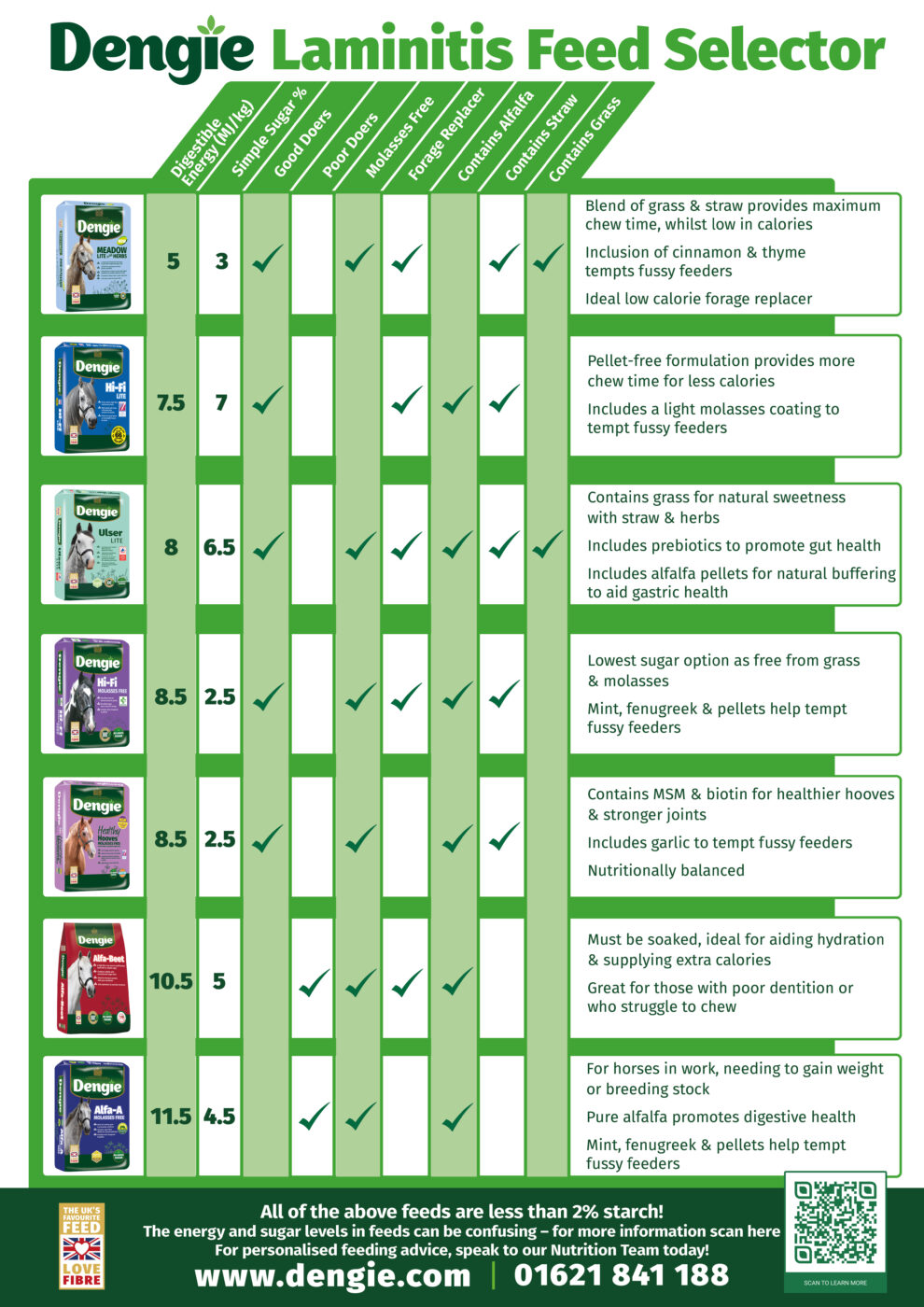
An area that often causes confusion is that products that are lowest in energy (calories) are higher in sugar. It is important to remember that all the Dengie feeds are relatively low in sugar, it’s just that when they are compared to one another, some contain more sugar than others. There are two groups of ingredients that make up the majority of Dengie feeds: the fibre sources – straw, alfalfa and grass and the coatings – molasses and rapeseed oil. These are the ingredients that provide nutrients such as protein and fibre as well as being the main sources of energy in the feeds. It is the relative proportions of these core ingredients that determine the nutrient levels.
There are two ingredients that contribute higher levels of sugar to the feeds which are grass and molasses. If we don’t use molasses then a light oil coating needs to be added. This is because fibrous ingredients such as grass, straw and alfalfa are very prone to shattering and can make a feed look very bitty. The coating provides some moisture to reduce the shattering and also helps to disperse other ingredients such as herbs, vitamins and minerals through the feed. Oil coatings provide more energy than molasses which is simply because oil is more energy dense than carbohydrates such as sugar.
Alfalfa is naturally very low in sugar but contains more energy than straw and so if we use alfalfa it helps to keep the sugar content down but the energy level comes up a bit. Grass is a popular ingredient in fibre feeds but any product with grass in will have higher levels of sugar than those that don’t. This is why we use it sparingly in feeds for those prone to laminitis.
All of these factors are considered when our nutritionists formulate feeds. Dengie have been growing and making fibre based feeds for over 50 years and so understand the challenges of working with high fibre materials better than anyone. You can be sure that all our feeds are safe and efficacious which is supported by independent endorsements from organisations like The Laminitis Trust, the Laminitis Site and the BETA Approval Mark for horses and ponies prone to ulcers.
What are feather mites?
Chorioptic Mange is caused by the feather mites Chorioptes equi that live on the surface layer of the horse’s skin. They are only about 0.3mm in size so can’t be easily seen by the naked eye. The mites feed on the skin debris and can live for around 70 days after hatching from eggs laid on the surface of the horse’s skin. The lower legs are the most common place for the mites to live and although feathered horse breeds seem to be most affected, they can be found in any breed of horse or pony.
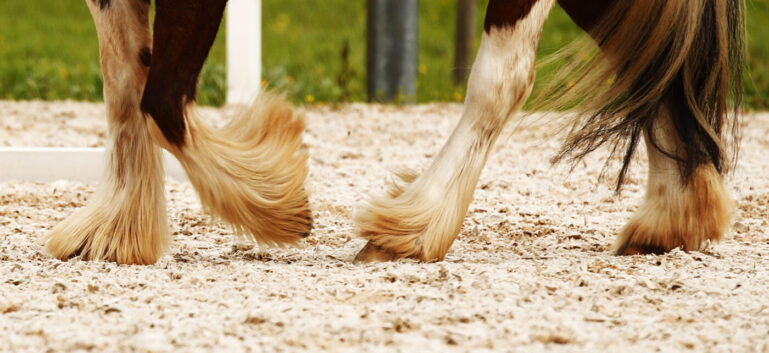
Symptoms of feather mites in horses
Itching, stamping and rubbing are all common symptoms which are caused by the irritation of the mites feeding and crawling on the horse’s skin.
Scurfy, flakey skin is another common symptom of chorioptic mange and is believed to be the skin’s natural defence to shedding the mites. Often, even when the mites have gone, the horse’s skin continues to flake.
What is mallanders and sallanders?
Occassionally, large crusty areas can form at the back of the horse’s knees which are know as mallanders or the front of the hocks known as sallanders. The thickening of the skin leads to scaling and a dandruffy appearance. Unfortunately, once these thickenings have formed it’s difficult to get rid of them and they are unlikely to ever totally go away.
Mallanders and Sallanders is linked to current or historic mites issues in heavy and feathered breeds of horses and so should be checked for regularly. Unfortunately, these breeds are particularly prone to them as hyperkeratinisation is also associated with having feathers.
Hyperkeratosis is a thickening of the outer layers of the skin triggered by the movement of the mites causing inflammation and in some cases infection. In a normal situation, the epithelial cells shed regularly but in hyperkeratinisation, excess keratin is formed and accumulates causing the normal shedding process to be disrupted. Keratin is a fibrous protein that is the main structure of the skin, hair, hooves etc and is produced by epithelial cells. Keratin is also essential for wound healing.
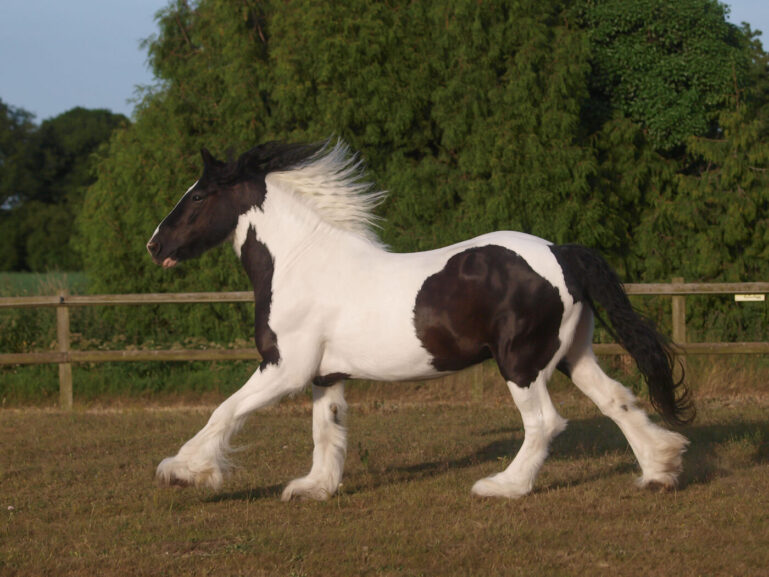
Treatment and management of feather mites
Chorioptic mange can be treated but it is difficult to get rid of it completely due to the mites living in the environment or on other horses thereby causing re-infection. This means regular treatments are often required. Complete elimination of mites is likely to require treating all the horses on the property at the same time as well as disinfecting all the stables and other communal areas.
Ivermectin and Doramectin, both active ingredients in wormers, as well as Fipronil which is in flea products, are all options which may be used to treat feather mites. Pig oil and sulphur is a traditional treatment which may also help. Clipping feathers off can help with applying treatments but is unlikely to resolve the issue on its own.
Mallanders and sallenders treatment
Often, attempts to remove the mallanders and sallanders in horses can do more harm than good. Usually, they are just unsightly but in some more extreme cases, they can become infected. Trying to keep them soft by using aqueous based creams can be beneficial if they are prone to becoming chapped.
Link to nutrition
Although nutrition and diet are frequently discussed on forums and linked to mites, mallanders and sallanders in horses, there isn’t any scientific evidence to support this information. For example, there is often talk, particularly on social media, of biotin making mallanders and sallenders worse however, there is no scientific evidence to support this. Biotin is a naturally occurring vitamin present at low levels in grass and forages and is produced internally by the horse itself as it breaks down fibre. It is therefore impossible to provide a diet which is completely free from biotin.
In fact, as hyperkeratosis is most commonly caused by mites, biotin supplementation will not worsen this condition, but a deficiency in biotin may do so. A study in chickens found that hyperkeratosis was a direct effect of biotin deficiency in humans has been found to lead to brittle nails, inflamed skin and weaker hair.
From a diet and nutrition perspective, supplying a balanced diet that provides adequate good quality protein plus vitamins and minerals are all important for general skin health and support. In addition, a small amount of a high quality oil rich in essential fatty acids such as omega 3, can also help skin health and suppleness.
For more information on feeding for a healthy skin and coat click here.
Many horses like a munch on the hedgerow bordering their paddock and will try to snatch a sneaky bit of cow parsley from the verge when out for a more leisurely hack. Replicating this diversity for the stabled horse has become a popular trend in the form of a hedgerow haynet, where hedgerow plants for horses are mixed with or fed alongside the normal forage ration. Bringing the outside inside has advantages of encouraging foraging behaviour, environmental enrichment and offering diversity in the diet.
Are there any plants I should avoid feeding horses?
Not every plant, shrub or weed in the UK is safe for your horse or pony to eat ,so it is very important to identify the correct hedgerow plants for horses and know that you are feeding your horse safely. The British Horse Society and the RSPCA have some useful pictorial guides to common poisonous plants.
What plants are safe for horses that I can use in my Hedgerow Haynet?
Whilst not an exhaustive list, horses may enjoy a variety of items including cow parsley, cleavers (sticky weed), hawthorn, hazel, blackberry, rosehips, thistles, nettles, dandelion and willow. Softer, non-prickly items are easier for us to handle especially if trying to put them in the haynet, whilst woodier plants like hawthorn, hazel and willow may be easiest for feeding from the floor unless they are young growth. If you grow your own at home, common herbs like peppermint, rosemary and thyme leaves can also be a tasty addition to the ration. Hedgerow herbs for horses are a popular addition!
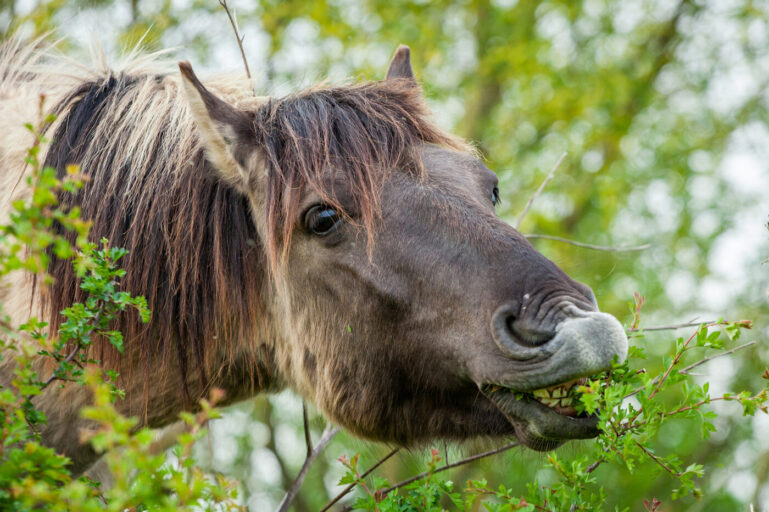
How much should I feed my horse?
Hedgerow plants for horses should be considered as a supplement to the forage ration and so should be fed in relatively small quantities e.g. a handful of each or less than 500g combined for a horse. This recommendation is to avoid sudden dietary change which increases the risk of digestive disturbance and to reduce significant fluctuation in nutritional intake. These materials will vary in nutritional value throughout the year and are being fed fresh whereas forages are conserved for use in winter and so are more stable in the levels of nutrients they are contributing to the ration. Mixing the hedgerow items through the usual forage encourages the horse to “forage” or sort through the different materials looking for those that are tastiest. This can extend eating time which is particularly useful for those on limited rations.
Will hedgerow items make a nutritional contribution to my horse’s diet?
With so many hedgerow items on offer and with none of them traditionally being used as part of the horse’s normal forage ration, we wanted to explore their nutritional value. Selecting just some of the items that our own horses find tasty we sent them for analysis. This had to be done using traditional wet chemistry techniques as equipment such as NIR, which relies on a bank of information from previous analyses, clearly wasn’t an option! It is important to highlight that these results are from just one sample of each plant and so should be considered indicative of what our horses were munching at that snapshot in time at the end of May. Much, much more analysis needs to be done to draw any firm conclusions about the nutritional value of these materials but it is really interesting to start exploring these materials.
| Nutrient*/Hedgerow Item | Hazel | Hawthorn | Cow Parsley | Sticky Weed | Average Hay |
|---|---|---|---|---|---|
| DE MJ/kg | 10.7 | 11.41 | 10.73 | 10.86 | 8 - 10 |
| Dry Matter % | 21.6 | 33.2 | 18.6 | 13.5 | 84 - 90 |
| Crude Protein % | 22.69 | 11.45 | 15.05 | 11.1 | 6 - 12 |
| Oil % | 0.78 | 4.25 | 4.41 | 3.48 | 1 - 3 |
| NDF % | 34.7 | 40.06 | 40.32 | 31.85 | 50 - 65 |
| ADF % | 22.73 | 32.32 | 29.68 | 30.89 | 30 - 40 |
| Starch % | 7.8 | 10.54 | 6.99 | 11.85 | 1 - 3 |
| WSC % | 4.86 | 4.3 | 13.7 | 20.74 | 9 - 17 |
*Analysis reported on a dry matter basis
For a greater understanding of the analysis used and nutrients analysed please see the Forage Analysis section of our website.
Can hedgerow haynets be given to laminitis prone horses?
One group of horses that we are always concerned about feeding extra treats to is those that are laminitis prone. It is very important not to assume that weeds or hedgerow items are any lower in sugar than grass or hay is. It is also important to appreciate that adding extra hedgerow items will provide more calories to the total diet too. Limiting these items to a treat only means that your horse doesn’t have to miss out completely.
Looking at the table above, Sticky Weed provides the highest combined WSC and starch levels of the hedgerow items tested. Based on the dry matter results, and if this was a hay and being fed at typical levels, we would certainly advise against feeding it to a laminitis prone horse or pony where we would generally recommend using forages with less than 10% WSC and starch combined. However, if we look at the percentage dry matter, Sticky Weed only contains 13.5% dry matter and therefore 86.5% of it is moisture which means the actual amount of sugar consumed would be relatively low. For example, 200g of Sticky Weed as fed would provide 5.6g of WSC, whereas 200g of a mid-quality hay (ie about 13% WSC) would supply more than double the WSC at 22.62g so context is everything!

Carrots are another similar example where, on a dry matter basis, the sugar level is high, but because they contain lots of water, the sugar level in the carrot as fed is much lower making them suitable as a treat if used in moderation. Always remember though that these items should be fed as a treat. If you are prone to “portion distortion” and just can’t resist feeding too much to your horse, then you may well be better off avoiding them altogether!
What can I use as a basis to my hedgerow haynet?
For good do-ers and those with insulin dysregulation, straw is a great source of forage that can mixed with the usual forage ration to encourage foraging behaviour without supplying too many additional calories or too much extra sugar. Whilst there has been some debate about the suitability of straw, recent studies are showing it is a useful feed material for good doers if used correctly. Click here for more advice on feeding straw to horses.
Top tips for making a hedgerow haynet
- Be absolutely sure you have picked things from the range of hedgerow herbs and plants for horses that are suitable for them to eat. If in doubt leave it out!
- Get inventive – place the hedgerow items around the paddock if your horse doesn’t have a hedge to help themselves to, or in the stable either mix through the usual forage ration or leave in separate nets or buckets to encourage foraging behaviour
- Use in moderation – feed a little, not a lot and always make gradual diet changes
- Don’t assume that hedgerow items are low in sugar, they may not be. Use as a treat only or not at all if you are concerned about laminitis
- Being novel, it may take a while for your horse to be interested in extra items in the haynet. Don’t worry if they take to sorting out and rejecting items you have picked and mixed in – this will still have kept them occupied and slowed the rate of consumption of the rest of their forage ration
- If you are competing under rules picking weeds and herbs could increase the risk of NOPS contamination and is best avoided. Click here for further information about prohibited substances.
Click here for further feeding advice or if you would like our nutrition team to review your horse or pony’s current ration.

